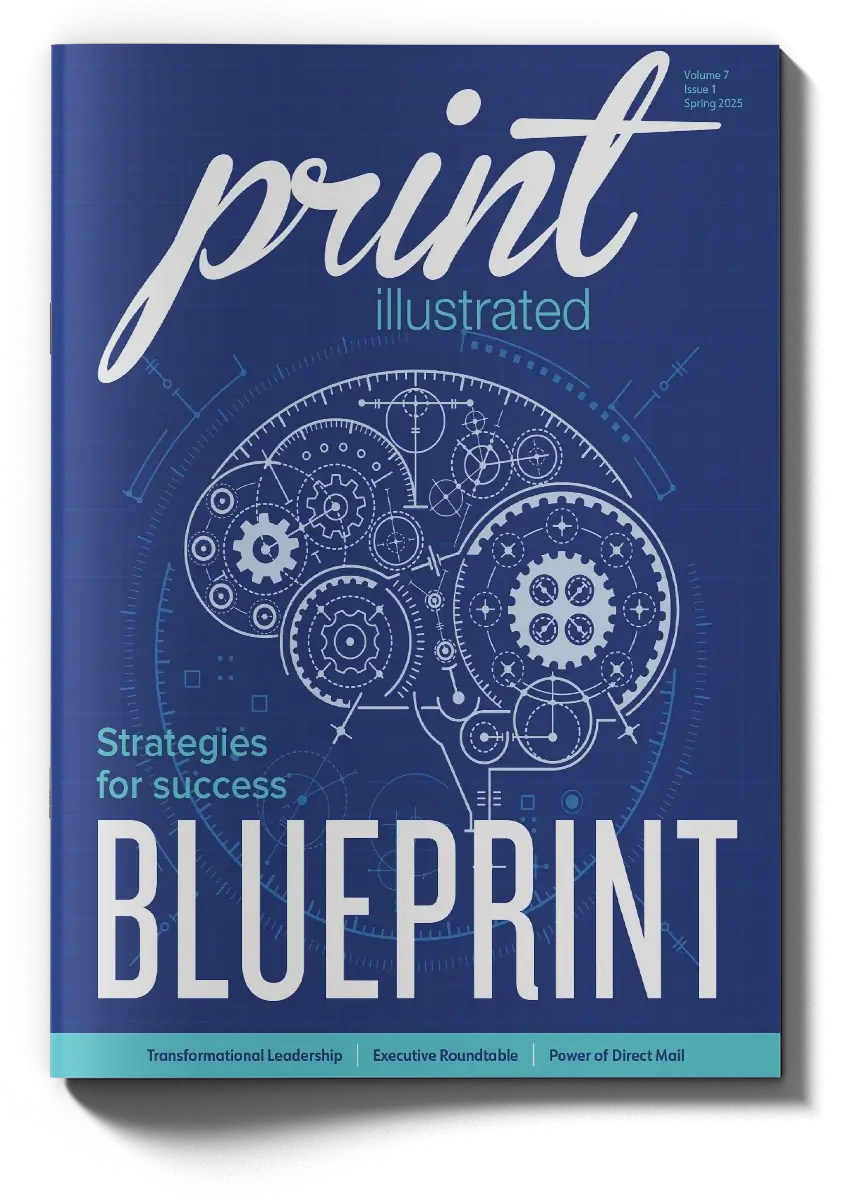KC Olson says the actions can be exhausting. All day, every day consumers are hit with a barrage of ads on everything from Google to Facebook. You query something and the fun begins. Pop ups and flashing blocks of ads overpower your senses until you silently scream into your device. And then, at the end of the day, you may get a piece of mail in your mailbox resulting from those same digital interactions.
This is where Olson says today’s printers have more opportunities than they are taking advantage of. Sure, seeing digital ads for products you just asked Siri or Alexa about is the norm, but actually getting something in your mailbox—something you can hold in your hands because of that engagement—leaves a lasting impression.
“Print companies will need to offer these services and make it easy for the consumers to connect these experiences,” says Olson, Director of Digital Print Technologies for ENPOINTE, the Brooklyn Park, Minnesota, printer that offers full spectrum mail and direct mail solutions. “Print has a more tactile approach and can evoke more of a personal connection with the piece. Holding a mail piece in hand can lead to a longer impression than a swipe of the finger on a phone screen. This emotional connection can drive engagement and loyalty in ways that are harder to replicate with digital media alone.”
“Print helps drive traffic to the digital space and the digital space enhances print mediums. They should never compete; we have found they work best together.”
– Alex Fechner, Director of Business Development, Advertisers Printing
In today’s digital landscape, supplementing physical mail pieces with digital channels and analytics reinforces brand awareness and allows for better tracking of ROI. Olson recalls a Travel Welcome Kit that included a video player with preset destination spots portrayed. Included in the kit were personalized itineraries, maps, and coupons targeted toward the consumer based on website survey answers and click history. “Brands need to know how to measure the impact of their mailing and what to look for. Take Informed Delivery. While it is a great tool, using it alone leaves a lot on the table. PQR codes, Promo codes and Mail Tracking can add so much more to the overall picture.”
Olson says having the personalized codes essentially narrows down the field to they is interested and what we should retarget with. In today’s competitive landscape, mail tracking is essential to get your timing right, hit your in-home dates and accurately measure your campaign conversion rate.
To help in the efforts, there are several software companies that offer personalization, including brands like Quadient Inspire Designer and XMPie. Tools and tricks include adding a Personalized QR Code (PQR) or Personalized URL (PURL), which offer a code that is trackable and can provide useful consumer information. “Direct correlations between print campaigns and sales spikes or increased online conversions can be tracked, especially when using unique promotional codes tied to print ads,” Olson says.
Target. Attack. Repeat.
Advertisers Printing’s direct mail program can be attached to up to 13 different mediums. When they use the program, its customers have access to a real-time dashboard that shows how their direct mail campaign is performing. The dashboard offers actionable data they can market with in the future.
Alex Fechner says that a nonprofit partner with the St. Louis-based print and direct mail solutions provider that made the decision to use the program has seen its investment pay off many times over. “Printed materials have a life that far surpasses digital mediums,” says Fechner, Director of Business Development. “I believe a direct mail piece’s average life is around 17 days. Printed materials also must be touched by someone, even if that someone is taking them out of the mailbox and dropping them into the recycle bin. To measure print piece attribution, you can add a call tracking number, a QR Code or a variable code that only lives on the mail piece.”
When these strategies are employed, printers can prove that the printed collateral motivated someone to take further action. Fechner says you also can run a match-back report to the mail list to see how many conversions and/or revenue was generated from those who received a mail piece. “Print helps drive traffic to the digital space and the digital space enhances print mediums. They should never compete; we have found they work best together.”
To effectively and strategically amplify the benefits of digital and print strategies, printers must continue to show the benefits of the mediums working together. For Advertisers Printing, matchback reports have been impactful. But, as Fechner recommends, the client must be willing to share new data from their CRM from when the campaign launches, which allows you to match the mailed records back to any new business generated.
“Holding a mail piece in hand can lead to a longer impression than a swipe of the finger on a phone screen. This emotional connection can drive engagement and loyalty in ways that are harder to replicate with digital media alone.”
– KC Olson, Director of Digital Print Technologies, ENPOINTE
“There are also ways of matching non-mailed records back to the customer,” Fechner says. “This is more complicated, but possible. If you can prove that a non-mail record interacted with a digital ad connected to the direct mail campaign converted, then there is more proof that an omni-channel approach is more successful than siloed marketing.”
As for the future of print and digital integrations, the success is in how you approach the strategy. Fechner says artificial intelligence (AI)-based programming and highly targeted data providers will enable customers to print and mail less with a greater ROI. “Strong IT, coding and sophisticated equipment/team members must be willing and on board to make all of these things happen.”
Olson believes that informed delivery will move into a paid ad space. “For example, USPS setting up a deal with Amazon or large retailers to offer postal incentives that enable Amazon to attach a ‘Ride-Along’ ad for a paid percentage of the mail piece.”
By seamlessly integrating print with digital strategies, progressive printing companies can create more engaging and effective customer experiences. This convergence will not only enhance brand interactions, but also drive measurable results. As the industry evolves, those who embrace innovation will remain at the forefront, transforming print into a powerful tool for the digital age.
5 Reasons Print and Digital Strategies Work Together
- Tactile Engagement Creates Lasting Impressions
While digital ads are easy to scroll past, a physical mail piece stays in a consumer’s hands longer, creating a stronger emotional connection and brand recall. - Data-Driven Personalization Enhances Response Rates
Print campaigns using Personalized QR Codes (PQRs) or Personalized URLs (PURLs) allow businesses to track engagement, measure ROI, and refine future marketing efforts. - Omnichannel Campaigns Drive Higher Conversions
When print and digital campaigns are aligned, consumers receive a consistent brand message across multiple touchpoints, increasing the likelihood of conversion. - Print Extends the Life of Digital Marketing
A direct mail piece can stay in a home for days or weeks, serving as a reminder of the digital interactions that led to it—unlike digital ads, which disappear quickly. - Advanced Tracking Bridges Online and Offline Engagement
By integrating call tracking numbers, match-back reports, and QR codes, marketers can link printed materials to digital actions, proving the effectiveness of print in a multi-channel strategy.
Source: Alex Fechner, Director of Business Development, Advertisers Printing; KC Olson, Director of Digital Print Technologies, ENPOINTE

